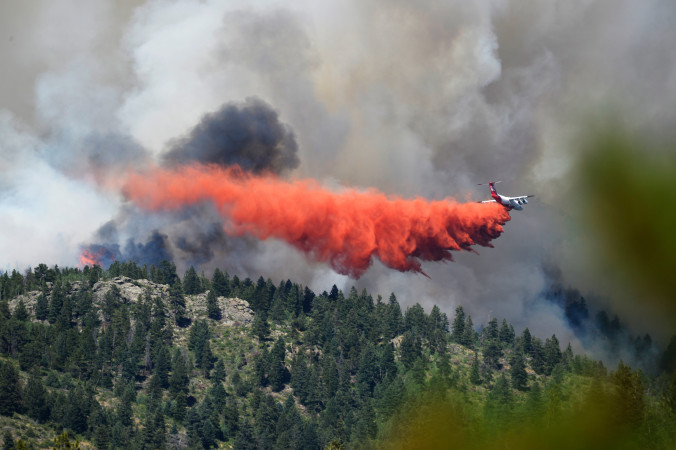A Guide to Volunteering During Fires
By: Carrie Terroux-Barrett
Wildfire season is upon us. That was made brutally clear yesterday when much of Colorado erupted into a firestorm in just hours, several large, structure threatening fires and a few smaller ones included. Colorado is no stranger to wild fires, and few words strike fear into the hearts of Coloradoans more than fire. The best part about this state though, is it’s people. Every time there’s a disaster the great folks here go out of their way to volunteer to help in any way they can. Being in the horse community, it is very common for thousands of offers to help to be made all over social media. They range from helping evacuate to helping to house horses, etc. I get a lot of messages during these times, asking how one can help. I have the same answers to everyone, and I thought this would be a great way to get it out there for everyone to read so the time of our dispatchers, call centers, extension offices and first responders can be spent where it needs to be spent.
FIRST AND FOREMOST, the biggest response we get is from folks wanting to assist with evacuations. PLEASE PLEASE read the following words and take them to heart. Horse evacuation is VERY DIFFICULT, VERY DANGEROUS, and VERY TRYING. It is seriously best left to trained professionals. I pray you never have to load a horse under stress, particularly under mandatory and immediate evacuation need of a fire. These animals need only handling from experienced evacuators, a panicky horse, or any livestock, is a force to be reckoned with and need to be handled as such. Tiny mistakes can cost lives or cause injury. Little things like proper halters, knowing your knots, having the right type of trailer, knowing how to run stock into a trailer, and what to do if you can’t get animals loaded are non negotiable. Livestock should never be evacuated in a straight load two horse trailer. Stock trailers are almost always preferred. Nearly all counties in the state have extensive training programs for Community Animal Response Teams (CART), Mounted Posses, etc. In the event of a mandatory evacuation, these teams are dispatched to handle evacuations. Forest fires are very dangerous and unpredictable, these teams have radio contact and are sent out to areas that may be in risk of being burned over, or exposed to fire, and they have been trained how to handle those situations. Civilians really have no place behind fire lines. Most areas expressly forbid civilian involvement in evacuations behind mandatory evac areas. This is for safety reasons. The safety of the citizens, the safety of the animals, and the safety of first responders who would have to go in and rescue a civilian who gets in over their heads. Areas like Boulder have many winding mountain roads with only one way in and out, getting trapped would be a nightmare, and there would be no way to track civilians attempting to evacuate horses, or warn them of impending danger. There are many horror stories first responders share of well meaning folks who go in to help and end up needing saved, requiring fire and first responders to divert their efforts to rescue people who should not have been there in the first place. I have heard counties and municipalities blasted for this policy, and that makes me angry. They are thinking of nothing more than everyone’s safety. As much as we all love horses, there is no animal worth a human life. There are laws, rules, guidelines that must be followed no matter who is managing the fire. Right now, there are lines of folks with trailers showing up to help, and being turned away. They are also wasting valuable resources and time. There are many properly trained evacuators, so please allow them to do their thing!
BUT YOU WANT TO HELP RIGHT?
Of course you want to help. So help where it counts! There are three ways to offer help that I just love,
1. VOLUNTEER AT THE EVACUATION AREA
These areas have an influx of animals coming in, they need help and a lot of it. They need help feeding, watering, documenting, cleaning, setting up, moving, etc. Someone with livestock experience is very useful here. You can also help by transporting feed, hay, and supplies as needed. Some evacuation areas need horses moved to vets, other facilities, or horses brought from staging areas to the facility. This is where civilians come in very handy, and do a tremendous service.
2. DONATE DONATE DONATE
Many fire evacuators are doing this out of their own good hearted nature. There often is no compensation. Many organizations that help also need donations. Evacuation centers often need donations of feed and supplies. (GOOD SUPPLY, YOUR TORN UP HALTERS/LEADS, CRACKED BUCKETS, BENT PANELS ARE NOT APPROPRIATE)
3. CARE PACKAGES
There was nothing more helpful or touching than the care packages handed out at staging areas at any fire I have helped with. A lunch bag with snacks to eat on the move, multiple drinks, wet wipes, kleenex, even sunglasses, and bandanas, can keep workers and first responders going. Get a group together, everyone buy one part, bag them up, and take them to a staging area to hand out, or pass them out to shelters, and people in lines to get back in to get their belongings, local fire stations, anywhere you can think of. I have been saved by these packages before, a bottle of water to wet a bandana to breathe through, a small first aid packet to fix up a barbed wire gash, it will be the best gift you can give that you will never know the meaning of.
10 Rules to Live by in Evacuations with Horses (Fire/Tornado/Etc)
By: CTB-Animal Control/Animal Evacuator
1. TEACH YOUR HORSE TO LOAD (and tie)! And I mean immediately step into a trailer.
2. Take at least one bale of hay and a BUCKET, you never know where your horse is going to end up.
3. No matter what, if you take your horses or not, MAKE SURE you take your proof of ownership/BRAND INSPECTIONS! This will help you prove the horses are yours later on! (Photos work in non brand inspection areas!)
4. If you CANNOT TAKE your horse, TURN THEM LOOSE! They have great survival instincts, its better than dying in a locked barn.
5. IF YOU TURN THEM LOOSE, write your phone number on them in some way! Spay paint/shoe polish, whatever you can find.
6. If you turn them loose TAKE THEIR HALTERS OFF! Imagine all the debris your horse is going to encounter! You don’t want them caught on !
7. If you turn them loose, LOCK THEM OUT OF THEIR BARN/PEN/STALL/YARD. They WILL go back!
8. If you take your horse to an evacuation center, it is still a good idea to have your horse marked in some way. Sometimes evacuation centers have to evacuate!
9. If you take your horse in a trailer, PLEASE tie them if you safely can! I cannot count how many times we were evacuating and found a loose horse we needed to load with ours, if the horses are loose in the trailer that is a disaster waiting to happen.
10. If your horse is in a large pasture area, cut the fence in corners and leave gates open! When horses can’t find their way in smoke/debris they will follow fence lines.






Leave a Reply
You must be logged in to post a comment.